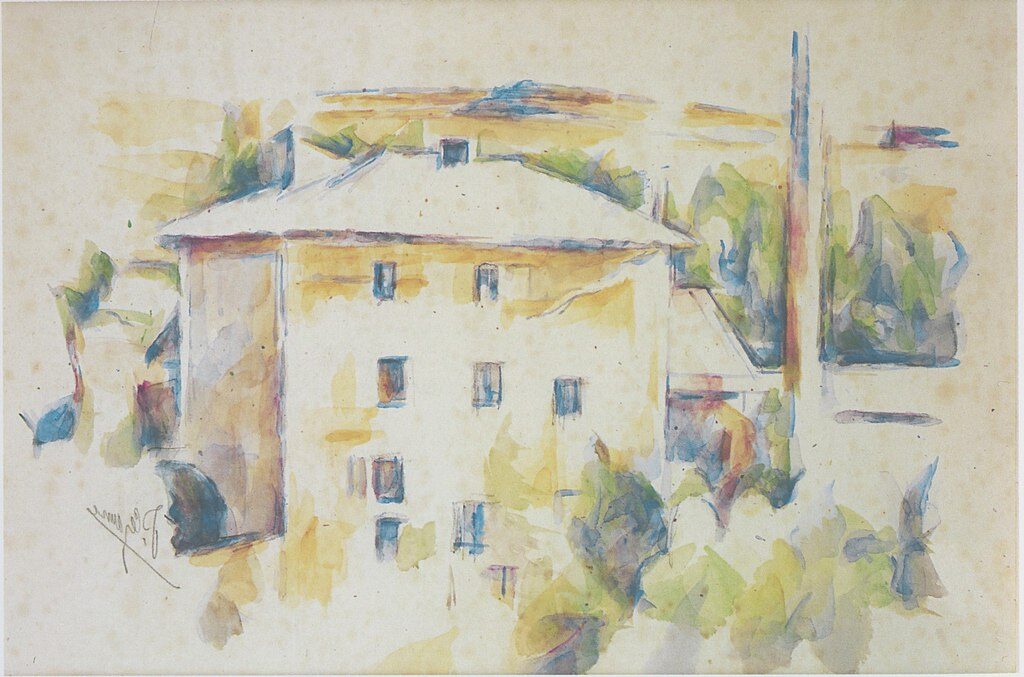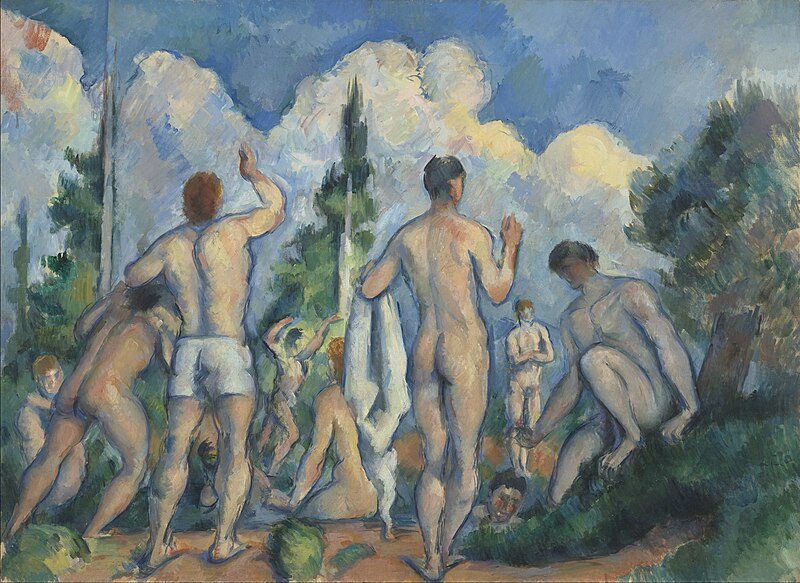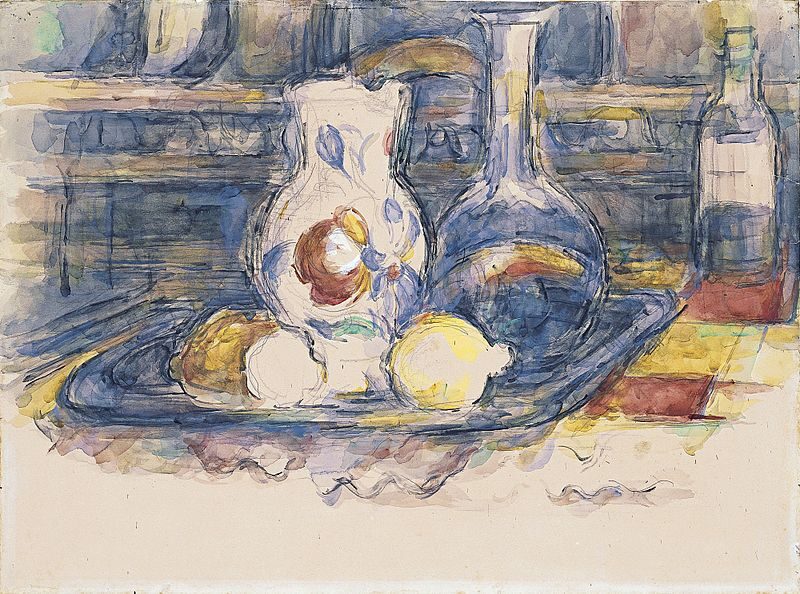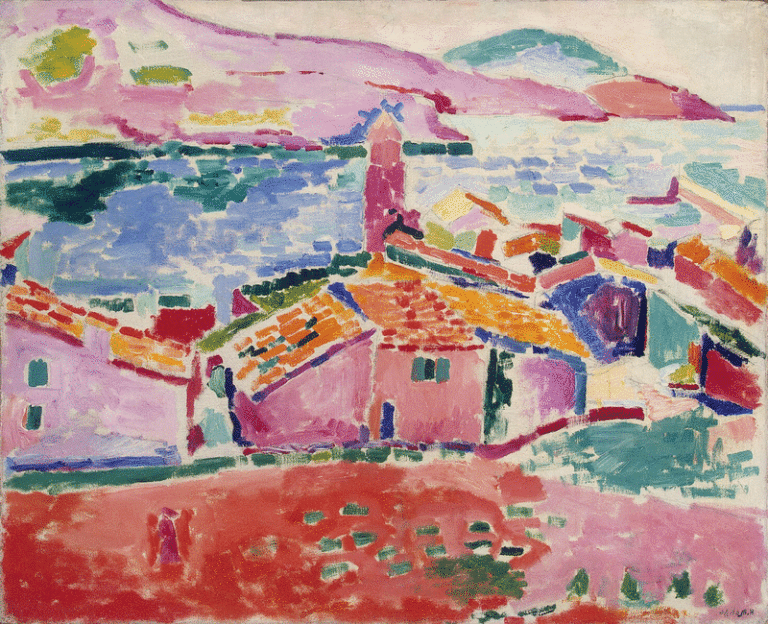Paul Cézanne Painter: Pioneering the Bridge to Modern Art
Born: 19 January 1839, Aix-en-Provence, France
Death: 22 October 1906, Aix-en-Provence, France
Art Movement: Impressionism, Post-Impressionism
Nationality: French
Teacher: Joseph Gibert
Institution: Académie Suisse, Free Municipal School of Drawing, and École de dessin d’Aix-en-Provence
Paul Cézanne Painter: Pioneering the Bridge to Modern Art
Life and Education of Paul Cézanne
Paul Cézanne’s journey from his birthplace in Aix-en-Provence to becoming a revolutionary painter was shaped by his family background, formal training, and key artistic relationships. His development as an artist reflected both his traditional education and his determination to forge a unique artistic path.
Early Life and Family Background
Paul Cézanne was born on January 19, 1839, in Aix-en-Provence, France. He grew up in a wealthy household, as his father was a successful banker and hat manufacturer.

Mill at the River (1900–1906) by Paul Cézanne
This financial stability later allowed Cézanne to pursue his artistic interests without immediate concerns about making money from his work. His mother, Anne Elisabeth Honorine Aubert, was affectionate and supportive of his artistic inclinations.
Cézanne attended the Collège Bourbon in Aix, where he formed a friendship with Émile Zola, who would become a famous writer. Their friendship proved significant in Cézanne’s life, with Zola encouraging his artistic pursuits.
Despite his father’s wishes for him to pursue law, Cézanne’s passion for art eventually prevailed. This tension between family expectations and artistic ambition marked his early years.
Formal Art Education and Influences
Cézanne’s formal art education began at the Free Municipal School of Drawing in Aix-en-Provence. Here, he studied under Joseph Gibert, gaining foundational skills in drawing.
In 1861, Cézanne moved to Paris to study at the Académie Suisse, where he met Camille Pissarro and Claude Monet. This period exposed him to the vibrant Parisian art scene and emerging Impressionist ideas.
He applied to the prestigious École des Beaux-Arts but was rejected. This rejection pushed him to develop his distinctive style outside traditional academic constraints.
Cézanne studied the masters at the Louvre, particularly admiring the works of Eugène Delacroix, Diego Velázquez, and Caravaggio. These classical influences are evident in his early dark palette and dramatic compositions.
Relationship with Camille Pissarro
Camille Pissarro became Cézanne’s most important mentor and friend during the 1870s. Their relationship transformed Cézanne’s approach to painting in fundamental ways.

Women Dressing (c. 1867) by Paul Cézanne
Pissarro encouraged Cézanne to lighten his palette and paint outdoors, directly observing nature. This shift from studio work to en plein air painting marked a crucial development in Cézanne’s artistic evolution.
During their time working together in Pontoise and Auvers between 1872 and 1874, Pissarro taught Cézanne to be more methodical and patient in his observations of nature.
Though Cézanne participated in the first Impressionist exhibition in 1874, he gradually moved beyond Impressionism. He maintained his respect for Pissarro even as he developed his own distinctive approach focusing on structure and form rather than fleeting atmospheric effects.
Artistic Style and Contributions
Cézanne developed innovative approaches to painting that bridged 19th-century Impressionism and the radical new artistic movements of the 20th century. His distinctive style transformed how artists approached form, perspective, and color relationships.
Development of Post-Impressionism
Cézanne began as an Impressionist but gradually moved beyond this style to create something truly original. During the 1870s, he worked alongside Impressionists like Pissarro, absorbing their techniques of painting outdoors and using vibrant colors.

The Plaster Kiln (1890–1894) by Paul Cézanne
By the 1880s, he broke away from Impressionist principles. He rejected their emphasis on capturing fleeting light effects and momentary impressions. Instead, Cézanne sought to create something more solid and enduring.
His mature style focused on underlying structure rather than surface appearance. He wanted to “make of Impressionism something solid and durable, like the art of museums.” This approach positioned him as a key founder of Post-Impressionism.
His later works show a careful balance between objective observation and personal expression. This tension became a defining characteristic of Post-Impressionism.
Use of Color and Brushwork
Cézanne developed a distinctive approach to color that moved beyond realistic representation. He used color to create form and depth rather than simply depicting how objects appeared.
His palette featured rich blues, greens, and warm earth tones applied in small, parallel brushstrokes. These brushstrokes, often called “constructive strokes,” built up surfaces that seemed to vibrate with energy.
He created modulations of color rather than smooth gradients. Different color patches sit next to each other, creating visual tension and depth.
Cézanne often left portions of canvas visible between brushstrokes. This technique created a sense of breathing space within his compositions and emphasized the flatness of the painting surface.
His approach to color relationships influenced color theory in modern art. He demonstrated how colors interact with neighboring hues to create visual sensations beyond literal representation.
Subjects and Motifs
Cézanne repeatedly returned to a few key subjects throughout his career. Mont Sainte-Victoire near his home in Aix-en-Provence appeared in over 60 paintings and watercolors.

Bathers (c. 1890) by Paul Cézanne
Still life arrangements featuring apples, oranges, and tableware allowed him to explore formal problems of composition. These seemingly simple subjects became laboratories for his artistic experiments.
Landscape scenes of Provence captured the distinctive Mediterranean light and terrain. He painted L’Estaque, Gardanne, and the Bibémus Quarry multiple times, finding new insights with each version.
Bathers became another significant theme, allowing Cézanne to explore the human figure in relation to nature. These works combine classical composition with modern painting techniques.
His portraits, including many self-portraits, demonstrate his interest in psychological depth beyond physical appearance.
Influence on Modern Art
Cézanne’s impact on 20th-century art is difficult to overstate. Pablo Picasso called him “the father of us all,” acknowledging his crucial influence on Cubism.
His approach to breaking down forms into geometric structures directly inspired Cubism’s fragmented perspectives. The faceted planes in his late landscapes appear in early Cubist experiments by Picasso and Braque.
Henri Matisse and the Fauves drew from Cézanne’s bold use of color as an expressive element independent of descriptive function.
Abstract Expressionists like de Kooning admired his brushwork and compositional tension. His influence extends to contemporary painters who continue to study his solutions to pictorial problems.
Major Works and Legacy
Paul Cézanne created several groundbreaking series of paintings that revolutionized art. His unique style influenced generations of artists and secured his place in major museums worldwide.
The Card Players Series
Cézanne painted “The Card Players” between 1890 and 1895. This famous series includes five paintings of peasants playing cards.

Les joueurs de cartes (The Card Players) (1892–1895) – Paul Cézanne
Each version shows different numbers of players in varying compositions. The paintings appear simple but contain complex arrangements of color and form.
The series represents Cézanne’s mature style with its carefully balanced compositions and solid figures. One version sold for over $250 million in 2011, making it one of the most expensive paintings ever purchased at that time.
Mont Sainte-Victoire Paintings
Mont Sainte-Victoire, a mountain near Cézanne’s home in Aix-en-Provence, became one of his most important subjects. He painted this landmark more than 60 times throughout his life.
These paintings show Cézanne’s evolving style. Early versions appear more traditional, while later works become increasingly abstract with geometric patterns.
The series demonstrates his approach to constructing nature through color planes. Each painting offers a different perspective and lighting condition, revealing how Cézanne studied the mountain’s unchanging structure through shifting appearances.
Still Life Compositions
Cézanne’s still life paintings stand among his most innovative works. His arrangements of fruit, especially apples, are instantly recognizable.
He approached still life subjects with careful attention to form and perspective. Objects appear slightly tilted or viewed from multiple angles simultaneously.
These paintings demonstrate his famous “constructive stroke” technique—applying small, parallel brushstrokes to build form. Works like “Still Life with Apples and Oranges” (1895-1900) show his mastery of color relationships and spatial arrangements that influenced cubism.
Recognition and Museums
During his lifetime, Cézanne received little public recognition. His first solo exhibition occurred only in 1895, eleven years before his death.

Bottle, Carafe, Jug and Lemons (1902–1906) by Paul Cézanne
Today, major museums worldwide display his work prominently. The Musée d’Orsay in Paris holds several masterpieces, while The Barnes Foundation in Philadelphia owns 69 Cézanne works—the largest collection anywhere.
His paintings inspired Picasso and Matisse, who called him “the father of us all.” Modern art movements including Cubism and Abstract Expressionism trace their roots directly to Cézanne’s innovations in form, perspective, and composition.
Frequently Asked Questions
Paul Cézanne’s revolutionary approach to painting transformed the art world with his distinct style, groundbreaking techniques, and profound influence on modern art movements. His works explored complex relationships between observation and expression across various subjects.
What are the defining characteristics of Paul Cézanne’s painting style?
Cézanne’s style features geometric simplification of natural forms. He reduced objects to their essential geometric shapes—cylinders, spheres, and cones.
His brushwork consists of small, parallel strokes creating a distinct texture. These methodical brushstrokes build up surfaces with careful attention to color relationships.
Cézanne often used multiple perspectives within a single painting. This approach rejected traditional one-point perspective, creating a slight shifting effect that makes objects appear viewed from different angles simultaneously.
His color palette emphasized blues, greens, and earthy tones. He developed a unique approach to color modulation, using subtle variations to create depth rather than traditional light and shadow.
How did Paul Cézanne contribute to the transition from 19th-century Impressionism to a new art movement?
Cézanne began as an Impressionist but moved beyond its focus on light and momentary effects. He sought to create something “solid and durable, like museum art.”
He emphasized structure and form rather than fleeting impressions. This shift laid crucial groundwork for Cubism and abstract art.
His work bridged traditional representational painting and modernist abstraction. Pablo Picasso famously called Cézanne “the father of us all,” acknowledging his pivotal role.
Cézanne’s analytical approach to breaking down visual reality influenced Cubism directly. His explorations of geometric forms and multiple viewpoints provided the conceptual foundation for Picasso and Braque’s innovations.
Can you list some of Paul Cézanne’s most influential works and explain their impact on art history?
“The Large Bathers” (1898-1905) represents his monumental achievement in figure composition. This painting’s geometric organization of nude figures in a landscape demonstrated how traditional subjects could be reinvented through modern formal concerns.
“Mont Sainte-Victoire” series (1880s-1906) shows his sustained examination of a single subject. These paintings reveal his evolving approach to structure, color, and space over time.
“Still Life with Apples and Oranges” (1895-1900) exemplifies his revolutionary still life work. The slightly tilted tabletop and multiple perspectives challenged conventional representation.
“The Card Players” series (1890-1892) depicts Provençal peasants with monumental dignity. These paintings feature remarkable structural solidity and careful color harmonies that influenced figurative art.
How did Paul Cézanne’s approach to composition and color theory influence future generations of artists?
Cézanne’s modulated color patches created form without relying on light and shadow. This approach inspired Fauvism’s liberation of color from descriptive purposes.
His exploration of pictorial structure rather than optical effects directly shaped Cubism. Picasso and Braque built upon his method of analyzing forms and multiple viewpoints.
Cézanne’s balance between representation and abstraction provided a model for modernism. He showed artists could simplify and restructure nature without abandoning it completely.
His technique of building surfaces through methodical brushwork influenced abstract expressionism. Artists like de Kooning acknowledged Cézanne’s approach to constructing paintings.
What were the main themes explored in Paul Cézanne’s artwork throughout his career?
Landscape was a central theme, particularly his beloved Provence. He painted Mont Sainte-Victoire over 60 times, exploring how to capture its essence through structural analysis.
Still life subjects allowed him to experiment with composition and form. His arrangements of fruits, bottles, and everyday objects became vehicles for formal innovation.
Bathers and nude figures in nature connected him to classical traditions. These compositions balanced formal concerns with references to mythological and pastoral themes.
Portraits and self-portraits revealed his interest in human psychology. Though fewer in number than other subjects, his figure paintings show remarkable psychological insight.
How did Paul Cézanne’s personal life and relationships affect his artistic development and oeuvre?
Cézanne’s early career was influenced by his complex relationship with his father. His father’s disapproval of his artistic pursuits created financial and emotional tensions. These tensions lasted until he received his inheritance.
His friendship with Émile Zola provided early encouragement but ended in estrangement. Their famous falling out reportedly occurred after Zola published “L’Œuvre.” The novel featured a failed artist character Cézanne felt resembled him.
Cézanne’s mature work was significantly shaped by his retreat to Aix-en-Provence. His relative isolation allowed him to develop his distinctive approach away from Parisian art trends.
His solitary nature was also influenced by his diabetes and difficult personality. These factors reinforced his intense focus on painting and his methodical, persistent approach to his subjects.








